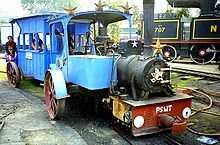National Rail Museum, New Delhi
Appearance



The National Rail Museum is a museum in Chanakyapuri, New Delhi which focuses on the rail heritage of India it opened on the 1 February 1977. It is located in over 10 acres (40,000 m2) of land with both indoor and outdoor exhibits. A toy train offers rides around that site on regular days.Museum remains open from 10.00 am to 5.00 pm (Last entry 4.30 pm) Tuesday to Sunday. Museum remains closed on every Monday and National Holidays. Apart from vast outdoor and state of the art Indoor Gallery. it is now equipped with 1:8 scale train, Diesel simulator, Steam Simulator, Coach Simulator and many more.
Main exhibits

- Patiala State Monorail Trainways: This unique steam monorail was built in 1907. This unusual train is based on the "Ewing System", and connected Bassi with Sirhind (approximate 6 miles). This was designed by Col. Bowles. The unique train system consists of a track of single rail. This mono track, the load-carrying wheel are run while one big iron wheel at other side to balance it and to keep the train upright. This train as built by Orenstein & Koppel of Berlin. This train ran till October 1927. In 1927, the line was closed with advent of better and faster modes of transportation such as cars and buses. Somehow, an engine and Chief Engineer's inspection car escaped being sold as scrap and remained in railway's scrap yard. In 1962, the remains of Patiala State Monorail Trainways was discovered by a railroad historian Mr. Mike Satow. Thereafter, one engine was restored to full working order by the Northern Railway Workshops at Amritsar. They also reconstructed the Chief Engineer's private inspection car on an old underframe. The two are now in running condition after being restored and are on display at National Rail Museum, New Delhi.[1]
- Fairy Queen, the world's oldest working steam locomotive in operational service.
- Fire Engine: Morris Fire Engine was built by the famous fire engineers M/s. John Morris and Sons Ltd of Salford, Lancashire in 1914. Only two Morris-Belsize fire-engine are known to exist in world today. Apart from the one with National Rail Museum, New Delhi, a 1912 model is preserved by the Enfield and District Veteran Vehicle. The fire engine preserved at the Enfield and District Veteran Vehicle, Whitewebbs Museum of Transport, Clay Hill, London, has been converted to use pneumatic tyres by Dennis Bros. Thus, the fire engine at National Rail Museum is the only one left in the world running on solid rubber tyres.
- Saloon of Prince of Wales: this saloon was built for Prince of Wales (later King Edward VII) for his visit to India.
- Saloon of Maharaja of Indore: This is saloon of Holkar Maharaja of Indore.
- Saloon of Maharaja of Mysore: This is personal saloon of Maharaja of Mysore. The saloon is designed using teak, gold, ivory, etc.

- Electric locomotive 4502 Sir Leslie Wilson: This 1928 WCG-1 locomotive belonged to the Great Indian Peninsular Railway (presently Central Railway). It is one of India's first generation 1,500V DC electric locomotives. Railway employees fondly remember this locomotives as "khekdas" (crabs) since they make a curious moaning sound when at rest and while on the run an unusual swishing sound from the link motion can be heard. Its unusual features included an articulated body, which made them ideal for use in heavily curved ghat sections. They were in operation as shunting locomotives until 1994 at Mumbai Chhatrapati Shivaji Terminus.

- Electric locomotive Sir Roger Lumley: This WCP-1 engine has wheel arrangements which are not seen these days. The locos were supplied from the Vulcan Foundry, UK in 1930. It was an electric locomotive which operated under 1,500V DC. It is famous for hauling the Mumbai—Pune Deccan Queen Express in the early years when it was launched. A prototype of this locomotive has been placed at the Nehru Science Centre, Mumbai for public viewing.



- Cranetank
- Kalka Shimla Rail Bus
- Matheran Rail Car No 8899
- Fireless steam locomotive
- Steam Locomotive A-885 HASANG
- Steam Locomotive X-37385 - This engine was used for trains to Ooty.
- MG Diesel SR 203 ( Fowler Diesel )
- Electric Locomotive YCG -E1/21900
- Betty Tramways ( Fowler Diesel ) - This used to run in Rajkot owned by Rajkot-Beti Tramways.

See also
References
External links
- Official Museum Website
- Article on National Rail Museum, Delhi by Rangan Datta
- An Enthusiasts site
- Photographic tour
Wikimedia Commons has media related to National Rail Museum, New Delhi.
